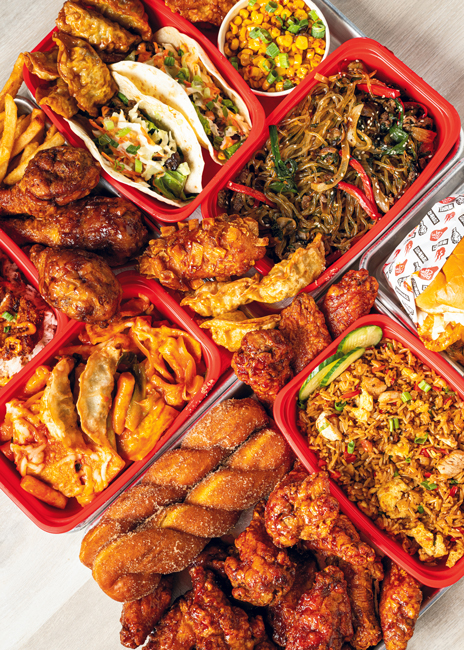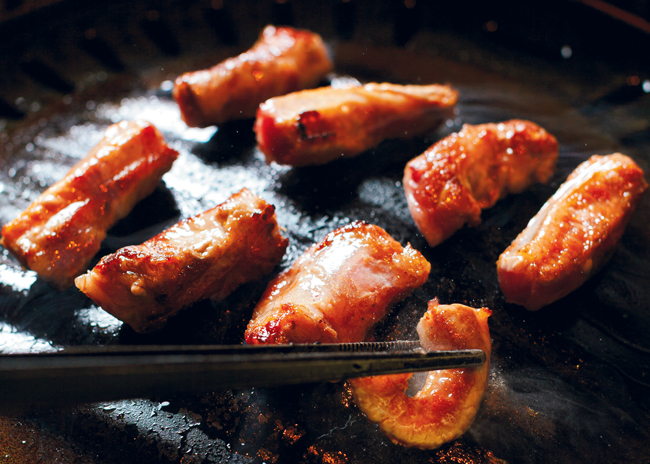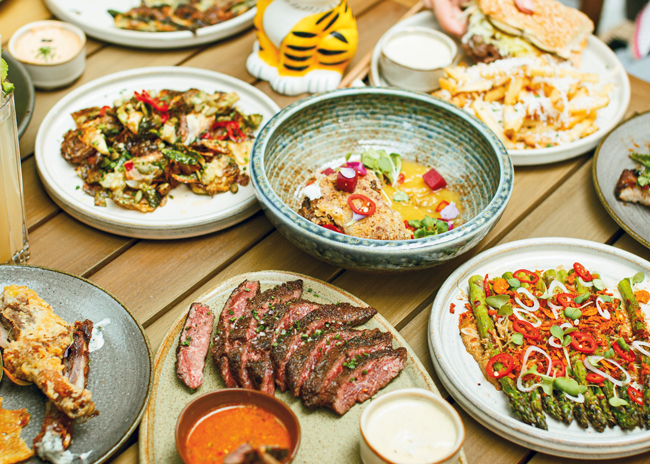No, it’s not your imagination. Korean food, like Korean beauty products and K-pop bands before it, is everywhere. From spice-forward fried chicken to boundary-pushing baked goods to elaborate multicourse meals, Korea’s culinary influences continue to find a welcome home on menus across a variety of restaurants in the United States and beyond.
 While Bonchon is most known for its Korean fried chicken, its expansive menu also includes traditional dishes like bibimbap and japchae, as well as fusion items such as bulgogi fries and Korean tacos. Photo courtesy BonchonAnd the numbers back it up. According to a September 2024 study released by market research firm Circana, there was a 10% increase in the number of Korean restaurants in the U.S. Since 2018, 450 new U.S. Korean restaurant locations have opened, including both quick- and full-service spots.
While Bonchon is most known for its Korean fried chicken, its expansive menu also includes traditional dishes like bibimbap and japchae, as well as fusion items such as bulgogi fries and Korean tacos. Photo courtesy BonchonAnd the numbers back it up. According to a September 2024 study released by market research firm Circana, there was a 10% increase in the number of Korean restaurants in the U.S. Since 2018, 450 new U.S. Korean restaurant locations have opened, including both quick- and full-service spots.
In large cities, Korean fine dining has carved out a niche all its own with chefs combining their heritage with luxury ingredients, traditional Korean culinary techniques and modern plating. At the 2025 James Beard Awards, Korean-leaning spots and their chefs took home a slew of awards, including Jungsik Yim of Jungsik for Outstanding Chef, Atomix for Outstanding Hospitality, JinJu Patisserie for Outstanding Bakery and Sky Haneul Kim of Gift Horse for Best Chef: Northeast.
Then there’s the expansion of H Mart, which started with a single store founded by a South Korean immigrant in 1982 in Queens, N.Y., to become the largest Asian supermarket chain in the U.S. with close to 100 locations. Korean-inspired food products can now also be found at mainstream markets like Trader Joe’s.
“Menu Matters just completed a massive global research project that looked at trends in over a dozen different countries, and it’s clear that Korean cuisine has not only been one of the biggest recent influences on U.S. dining culture and trends, but it’s also impacting what consumers are eating around the world,” says Mike Kostyo, Menu Matters vice president.
Kostyo cites kimchi (spicy vegetable dish) and gochujang (a spicy paste used in Korean cuisine) as a dish and ingredient, respectively, that helped pave the way for greater adoption of Korean cuisine in the U.S. Korean barbecue, fried chicken, bulgogi (Korean marinated beef) and kimbap (rice-filled seaweed-wrapped rolls) came next. Korean corn dogs, which made appearances at many a state fair this summer, followed. “It wasn’t long ago that the majority of U.S. consumers wouldn’t be able to tell you a single Korean dish,” he adds.
 At Chicago’s Perilla Fare and sister spot Perilla Steakhouse tableside grilling is part of the experience that combines traditional Korean ingredients and more modern dishes to create a cuisine that embraces the owners’ Korean American background. Photo courtesy of Perilla Fare; Photo by Jeremy Yap
At Chicago’s Perilla Fare and sister spot Perilla Steakhouse tableside grilling is part of the experience that combines traditional Korean ingredients and more modern dishes to create a cuisine that embraces the owners’ Korean American background. Photo courtesy of Perilla Fare; Photo by Jeremy Yap
Taking Flight
Since establishing itself in the U.S. in 2006, South Korean-born Bonchon now has more than 400 fast-casual restaurants across 8 countries. Primarily known for its Korean-style double-fried chicken hand-brushed with signature sauces, Bonchon also offers a variety of traditional Korean dishes such as bibimbap (mixed rice dish), bulgogi and tteokbokki (spicy rice cakes).
“Over the past five years, Korean restaurants in the U.S. have experienced a significant transformation, both in terms of popularity and how they operate,” says Jessica Kashoid, head of marketing at Bonchon. “There has been a notable surge in mainstream interest in Korean cuisine, largely fueled by the broader wave of Korean cultural influence in the U.S. This cultural momentum has helped Korean restaurants move beyond major metropolitan areas with established Asian populations and into new, less expected markets.”
Another area of change Kashoid has seen is the diversification of types of Korean restaurants, expanding beyond traditional barbecue spots and mom-and-pop establishments, as well as changes in the food available to consumers. “Menu offerings are also becoming more approachable to appeal to first-time Korean food diners, while still staying authentic enough for those familiar with the cuisine,” she says.
In Chicago, Perilla Fare and its newer, fancier sibling, Perilla Steakhouse — named after a leafy herb from the mint family that is used in Korean cuisine — embrace both those philosophies with wiggle room to allow for creativity.
Opened in 2019, Perilla Fare centers on traditional Korean flavors and ingredients and features tableside grilling. But it also has a hip vibe attracting a younger audience, especially for its patio pop-up events. “We started this restaurant six years ago with a focused intention to create a modern Korean restaurant through our lens,” says co-founder and general manager Thomas Oh, who, like chef/partner Andrew Lim, is Korean American. “We really wanted to put a focus on bridging that gap and making this as comfortable and approachable as possible for people to come in and learn about our culture through our food.”
Adding to the equation of both places is the extensive culinary backgrounds of Lim and Oh, who worked at a variety of non-Korean restaurants before looking toward their heritage and the food they ate growing up for inspiration.
Perilla Steakhouse, which opened last year in Chicago’s downtown area, embraces a sophisticated steakhouse vibe infused with Korean flair both in its menus and design. Located on the ground floor of the L7 Hotel, the restaurant’s interior design offers nods to traditional Korean homes, while servers’ uniforms are inspired by Korean garments. Chopsticks are specially ordered from Korea, and some of the restaurants’ serving ware is custom made by a local Korean American artist.
Throughout the breakfast, lunch and dinner menus, Lim weaves in Korean ingredients while also acknowledging the restaurant’s location in a hotel and its focus as a steakhouse. A Korean tray of rice, soup, assorted banchan (Korean side dishes) and a choice of protein has become a top seller at breakfast and lunch. At dinner, the tableside grill sets come with sides like ssam (lettuce- or perilla-wrapped dishes), japchae (sweet potato noodles) and ssamjang (spicy soybean sauce). The meat options include Wagyu hanger steak and short rib and are often marinated in traditional Korean spices. Cross-cultural dishes such as monkey bread with gochujang honey butter and kimchi pork dumplings in parmesan broth have earned plenty of fans.
While Korean cuisine has deep historic roots, its recent popularity can be linked to more modern phenomena. “The main driver of Korean trends in the U.S. has been social media and instant global communication, coupled with South Korea’s very trend-driven cultural exports,” says Kostyo. “Today, you have U.S. consumers watching Korean television shows, listening to K-pop bands and watching TikToks of Korean street food culture and mukbang influencers.” [Mukbang refers to videos of people eating].
Technology has also had a hand in its expansion. Like at many restaurants, the pandemic played a major role in reshaping dining behaviors at Bonchon, says Kashoid. “As off-premises dining — delivery and takeout — became essential during COVID, restaurants that could adapt quickly thrived. Bonchon leveraged this shift by enhancing our digital platforms, streamlining online ordering and focusing on packaging food that travels well.”
 Perilla Fare’s menu ranges from scallion pancakes and kimchi fried rice to gochujang pork ribs and chicken tender sandwiches with fries. Photo courtesy of Perilla Fare; Photo by Jeremy Yap
Perilla Fare’s menu ranges from scallion pancakes and kimchi fried rice to gochujang pork ribs and chicken tender sandwiches with fries. Photo courtesy of Perilla Fare; Photo by Jeremy Yap
Equipment Distinctions
When it comes to equipment, Korean food has some distinct requirements. “Dedicated Korean spots often have a wide range of unique needs, whether it’s the tabletop grills and sauce stations for a Korean barbecue concept or simply condiment caddies at the table or stone bowls for bibimbap,” says Kostyo. “With so many younger consumers embracing Korean cuisine, there is often a tech component too, whether that’s kiosks or tablets for ordering or roaming robots to deliver drinks and sides.” Korean cuisine’s emphasis on fermented products has led some operators to showcase their house-made products like kimchi or banchan in customer-facing refrigerators, he adds.
At Bonchon, the flattop grill represents one of its most important pieces of equipment, says Ashley Helkenn, senior director of learning and development and operations services. “It’s essential for preparing many of our core Korean dishes, offering the versatility and consistent heat we need to execute traditional cooking techniques with high volume and speed.” All Bonchon’s equipment is integrated with its KDS, which enhances efficiency, minimizes errors and ensures smooth, streamlined order tracking.
 Since coming to the U.S. in 2006, international fast-casual chain Bonchon has earned plenty of loyal fans for its Korean-inspired cuisine and lively atmosphere. Photo courtesy Bonchon
Since coming to the U.S. in 2006, international fast-casual chain Bonchon has earned plenty of loyal fans for its Korean-inspired cuisine and lively atmosphere. Photo courtesy Bonchon
With new prototypes, Bonchon prioritizes improvements to kitchen flow, aiming to make its cooklines more efficient and better suited for high-volume service. One key upgrade is investing in more premium, high-efficiency fryers. “Since our core product is fried chicken, our fryers must deliver on speed, consistency and quality,” says Helkenn. “These upgraded models offer faster recovery times, more precise temperature control and greater oil management, all of which help us maintain product integrity during peak service times while improving overall kitchen performance.”
At both Perilla restaurants, tableside grills become a defining element. “The biggest thing that we’ve tried to communicate is changing the dialogue on what Korean barbecue will look, feel and smell like in a restaurant,” says Oh. Custom grill tables where the exhaust system is built into the tables means they are smokeless. “You’re not going to leave smelling like what you ate,” he adds.
In the back of the house, multiple rice cookers are a given, says Lim, along with stone pots for cooking bibimpap and kimchi fried rice. Rectangular-shaped pans are used to create Perilla’s omelets. While in the kitchens of other fine dining restaurants, chefs often use tweezers to plate dishes, Lim relies on chopsticks to apply finishing touches.
When it comes to the future of Korean cuisine in the U.S., Oh finds plenty to be excited about. “I think most people are still very new to this, and we’re just starting to scratch the surface,” he says. “What people are going to realize at some point — and I hope sooner than later — is that Korean food is just so dynamic. And while maybe it’s bulgogi and Korean fried chicken that gets someone in our doors, we’re really excited to introduce them to all other possibilities of this cuisine.”



